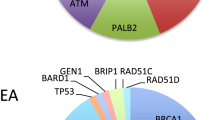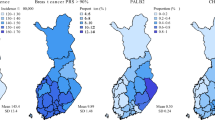Abstract
The incidence of breast cancer rises steeply between ages 25 and 50, and more slowly thereafter. In contrast, the incidence in the unaffected (contralateral) breast of women who have had breast cancer remains constant at about 0.7% per year for at least the next 20 years after diagnosis, irrespective of age at first diagnosis. The incidence in relatives of the patients seems to show a similar pattern. The incidence in a prospective study of monozygotic twins of patients was approximately constant at 1.3% per year (77 cases), again about 0.7% per breast. At ages older than a patient's age at diagnosis, her mother and sisters have an incidence of 0.3–0.4% per year. Above the index patient's age at diagnosis, the rate in relatives shows no temporal trend and is independent of the patient's age at diagnosis. A statistically simple explanation is that incidence in susceptible women increases to a high constant level by a predetermined age that varies between families, but this seems inconsistent with conventional models of carcinogenesis and susceptibility. The very high incidence in monozygotic twins of patients indicates that a high proportion, and perhaps the majority, of breast cancers arise in a susceptible minority of women.
This is a preview of subscription content, access via your institution
Access options
Subscribe to this journal
Receive 12 print issues and online access
$209.00 per year
only $17.42 per issue
Buy this article
- Purchase on Springer Link
- Instant access to full article PDF
Prices may be subject to local taxes which are calculated during checkout

Similar content being viewed by others
References
Harvey, E.B. & Brinton, L.A. Second cancer following cancer of the breast in Connecticut, 1935–82. Natl Cancer Inst. Monogr. 68, 99–112 (1985).
Robbins, G.F. & Berg, J. Bilateral primary breast cancers—a prospective clinicopathological study. Cancer 12, 1502–1529 (1964).
Bernstein, J.L., Thompson, W.D., Risch, N. & Holford, T.R. Risk factors predicting the incidence of second primary breast cancer among women diagnosed with a first primary breast cancer. Am. J. Epidemiol. 136, 925–936 ( 1992).
Boice, J.D., Harvey, E.B., Blettner, M., Stovall, M. & Flannery, J.T. Cancer in the contralateral breast after radiotherapy for breast cancer. N. Engl. J. Med. 326, 781–785 (1992).
Swerdlow, A.J., De Stavola, B.L., Swanwick, M.A. & Maconochie, N.E.S. Risks of breast and testicular cancers in young adult twins in England and Wales: evidence on prenatal and genetic aetiology . Lancet 350, 1723–1728 (1997).
Ahlbom, A. et al. Cancer in twins: genetic and non-genetic familial risk factors . J. Natl Cancer Inst. 89, 287– 293 (1997).
Claus, E.B., Risch, N.J. & Thompson, W.D. Age at onset as an indicator of familial risk of breast cancer. Am. J. Epidemiol. 131, 961– 972 (1990).
UK National Case-Control Study Group. Oral contraceptive use and breast cancer risk in young women. Lancet 1 , 973–982 (1989).
Peto, J. et al. Prevalence of BRCA1 and BRCA2 gene mutations in patients with early onset breast cancer. J. Natl Cancer Inst. 91, 943–949 (1999).
Claus, E.B. Age of Onset and the Inheritance of Breast Cancer Thesis, Yale Univ. (1988).
Peto, J., Easton, D.F., Matthews, F.E., Ford, D. & Swerdlow, A.J. Cancer mortality in relatives of women with breast cancer: the OPCS study. Int. J. Cancer 65, 275–283 (1996).
Olsen, J.H., Seersholm, N., Boice, J.D., Kruger Kjaer, S. & Fraumeni, J.F. Cancer risk in close relatives of women with early-onset breast cancer—a population-based incidence study. Br. J. Cancer 79, 673– 679 (1999).
Hislop, T.G. et al. Second primary cancers of the breast: incidence and risk factors . Br. J. Cancer 49, 79– 85 (1984).
Ford, D. et al. The Breast Linkage Consortium. Genetic heterogeneity and penetrance analysis of the BRCA1 and BRCA2 genes in breast cancer families. Am. J. Hum. Genet. 62, 676–689 (1998).
Waterhouse, J., Muir, C., Correa, P., Powell, J. & Davis, W. Cancer Incidence in Five Continents: IARC Scientific Publications No. 15 (International Agency for Research on Cancer, Lyon, 1976).
Claus, E.B., Risch, N.J. & Thompson, W.D. Genetic analysis of breast cancer in the CASH study . Am. J. Hum. Genet. 48, 232– 241 (1991).
Bernstein, J.L., Thompson, W.D., Risch, N. & Holford, T.R. The genetic epidemiology of second primary breast cancer. Am. J. Epidemiol. 136, 937–948 (1992).
Braun, M.M., Ahlbom, A., Floderus, B., Brinton, L.A. & Hoover, R.N. Effect of twinship on incidence of cancer of the testis, breast and other sites (Sweden). Cancer Causes Control 6, 519–524 (1995).
Ekbom, A., Hsieh, C.C., Lipworth, L., Adami, H.O. & Trichopoulos, D. Intrauterine environment and breast cancer risk in women: a population-based study. J. Natl Cancer Inst. 89, 71–76 ( 1997).
Cerhan, J.R. et al. Twinship and risk of postmenopausal breast cancer. J. Natl Cancer Inst. 92, 261–265 (2000).
Roberts, S.A. et al. Heritability of cellular radiosensitivity: a marker of low-penetrance predisposition genes in breast cancer? Am. J. Hum. Genet. 65, 784–794 (1999).
Fisher, B. et al. Tamoxifen for prevention of breast cancer: report of the National Surgical Adjuvant Breast and Bowel Project P-1 Study. J. Natl Cancer Inst. 90, 1371–1388 ( 1998).
Early Breast Cancer Trialists' Collaborative Group. Tamoxifen for early breast cancer: an overview of the randomised trials. Lancet 351, 1451–1467 ( 1998).
Houlston, R.S. & Peto, J. Genetics and the common cancers. in Genetic Predisposition to Cancer (eds Eeles, R.A., Ponder, B.A.J., Easton, D.F. & Horwich, A.) 208– 226 (Chapman and Hall, London, 1996).
Slack, F. & Ruvkun, G. Temporal pattern formation by heterochronic genes. Annu. Rev. Genet. 31, 611–634 (1997).
Acknowledgements
We thank the women who participated, J. Cairns for discussions and the UK National Case Control Study Group. The UK case control studies were funded by the Cancer Research Campaign, the Imperial Cancer Research Fund and the Medical Research Council. The US twin studies were supported by grants R01CA32262 and R35CA42581 from the National Institute of Health. J.P. is supported by the Cancer Research Campaign.
Author information
Authors and Affiliations
Corresponding author
Rights and permissions
About this article
Cite this article
Peto, J., Mack, T. High constant incidence in twins and other relatives of women with breast cancer. Nat Genet 26, 411–414 (2000). https://doi.org/10.1038/82533
Received:
Accepted:
Issue Date:
DOI: https://doi.org/10.1038/82533
This article is cited by
-
Risk of contralateral breast cancer according to first breast cancer characteristics among women in the USA, 1992–2016
Breast Cancer Research (2021)
-
Examining the etiology of early-onset breast cancer in the Canadian Partnership for Tomorrow’s Health (CanPath)
Cancer Causes & Control (2021)
-
Germline variants in cancer genes in high-risk non-BRCA patients from Puerto Rico
Scientific Reports (2019)
-
Preventing Common Hereditary Disorders through Time-Separated Twinning
BioNanoScience (2018)
-
Gene-expression patterns in peripheral blood classify familial breast cancer susceptibility
BMC Medical Genomics (2015)



